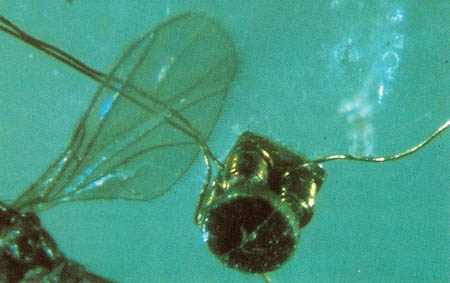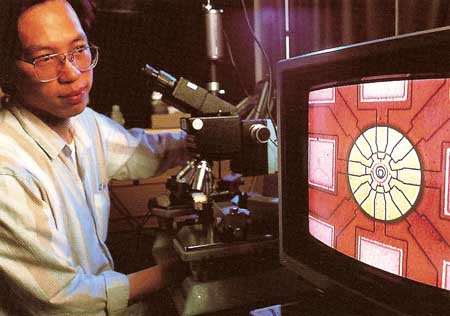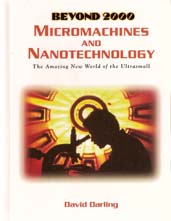MICROMACHINES AND NANOTECHNOLOGY: The Amazing New World of the Ultrasmall - 6. Amazing Nanotechnology

Figure 1. William McLellan's prize-winning electric motor, which would fit inside a cube one sixty-fourth of an inch across, is seen next to a gnat's wing.

Figure 2. The development of powerful machines of ever smaller size promises to bring great changes to the world in which we live.
In 1959, when Richard Feynman suggested the possibility of building structures one atom or molecule at a time, the idea seemed fantastic. Even Feynman underestimated how rapid future progress in miniaturization would be.
Feynman offered a $1,000 prize to the first person who could make a working electric motor that would fit inside a cube that measured 1/64 of an inch on each side. He guessed it would be a long time before he had to pay up. But just two and a half months later, William McLellan, a physicist at the University of California Institute of Science and Technology, claimed the prize. Working on his lunch breaks with a microscope, toothpick, and watchmaker's lathe, McLellan assembled a motor that met Feynman's requirements (see Figure 1).
As we have seen, in the years since then, scientists have made enormous progress in developing new techniques of miniaturization. They have also taken great strides in other fields, such as learning how the chemicals inside our bodies work to help us grow and stay alive and healthy. In the years ahead, the dream of nanotechnology may come true as researchers put together the knowledge and methods from areas such as chip technology, micromechanics, and biochemistry (the study of the chemicals of life).
Nanomachines of the Future
Nature has been manufacturing complicated products from individual molecules for almost 4 billion years – for as long as there has been life on Earth. Your body is made of trillions of microscopic, living units called cells. Each cell is like a miniature factory that builds complex chemicals from relatively simple raw materials. The plans for making these chemicals are stored inside a special molecule called DNA. Other molecules act as messengers, carrying the instructions from DNA to sites within the cell, where the essential chemicals needed for life, including proteins, are put together.
What nature can do, it may be possible for human beings to copy. Perhaps in the future scientists will create "assemblers." These would be small machines that would take in raw materials from their surroundings and piece them together, atom by atom and molecule by molecule. They would be programmed to carry out certain constructions tasks, turning out specific nanomachines by means of miniature assembly lines.
Every hour, entire factories no larger than a grain of sand might generate billions of machines that would look like a mass of dust streaming steadily out from the tiny factory doors. The purpose of these nanomachines would be determined by the programmed instructions of the factories that made them. They might be devices for cleaning up oil spills or other forms of pollution. They might be miniature submarines that could be injected into a person's bloodstream to destroy cancer cells or attack fat deposits.
The possible uses of nanomachines stretch our imagination to the limit. They could, for instance, be used to manufacture food in any desired amounts, wherever and whenever it was needed. Scientists have even suggested the possibility of a nano "meat machine" that would create fresh meat from raw materials in the environment. There could also be nano "egg machines" and "wool machines," so removing the need to keep animals at all for human use.
| A Slippery Problem
How do you keep a nanomchine running smoothly? A car engine has to be well lubricated with oil; otherwise the friction between its moving parts quickly causes the engine to overheat and seize up. But the methods of lubricating an ordinary-size machine would not work with a device that was only as big as a large molecule. At this scale, the effects of individual molecules of oil sliding against one another would become overwhelming – the oil would seem as sticky and sluggish as tar.
Fortunately, it might not be necessary to lubricate bearings in nanomachinery at all. As Richard Feynman pointed out, such tiny bearings could be allowed to run dry since and heat they produced would escape almost immediately. |
A World Transformed
We are still many years away from seeing these astonishing developments. However, it would be a mistake to suppose that they could not happen at all. What to one generation might seem – or unacceptable – can seem commonplace to the next. Microchips and scanning-tunneling microscopes would have appeared incredible 50 years ago. But now they are a reality.
The prospects for nanotechnology are extraordinary. Just as today we are surrounded by countless numbers of tiny creatures that live on us and inside us, so our world may eventually include trillions upon trillions of artificial molecule-sized machines.
These nanomachines could be used for much that is good. They could keep our environment clean, mopping up pollutants as soon as they are released. They could do hazardous jobs, such as working underground or in nuclear reactors, that today have to be carried out by people. They could help us to live longer and healthier lives.
But, as with almost all forms of technology, there is the possibility for misuse. Just as an army of micromachines could be programmed for constructive purposes, so it could be turned to terrible ends. Perhaps more seriously, there is the possibility that nanomachines might be given the wrong instructions by mistake. For instance, an army of such devices intended to clean up pollution might cause further damage to the environment instead. This raises a serious question. If malfunctioning nanomachines did go on the rampage, how would we ever find them so that we could stop what they were doing?
We stand on the brink of a world that may be transformed by devices that
we cannot even see. One way or another, nanotechnology promises to be among
the most far-reaching developments of the twenty-first century.

